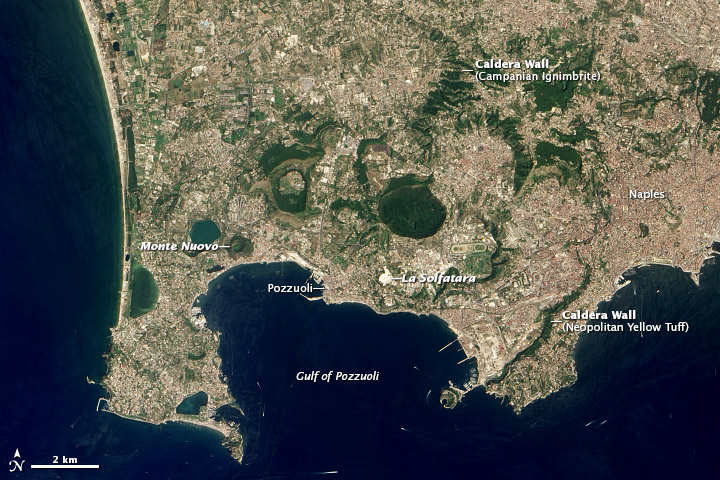Archive for the ‘Volcano’ Category
5/18/1980: Mount St. Helens in Washington erupts, causing a massive avalanche and killing 57 people
Saturday, May 18th, 20193/29/1982: The combination of an earthquake and a volcanic eruption at El Chichon in southern Mexico converts a hill into a crater, kills thousands of people and destroys acres of farmland
Friday, March 29th, 2019Volcanologists report that Campi Flegrei , in and around which 1.5 million inhabitants live, is at the start of an eruption cycle
Thursday, November 15th, 2018
The Campi Flegrei caldera cluster is the largest volcanic feature along the Bay of Naples, which is also home to the more famous Vesuvius. The Campi Flegrei, or “Fiery Fields,” is built from a series of overlapping volcanic features—calderas, domes, and cinder cones—that are historically active.
The Campi Flegrei calderas have produced two of the largest eruptions Europe has seen in the past 40,000 years. The Neopolitan Yellow Tuff (rock composed of fragments of material embedded within volcanic ash) was erupted roughly 12,800 years ago, with a total volume of at least 40 cubic kilometers (10 cubic miles). The Campanian Ignimbrite (rock made from the fused remnants of a pyroclastic flow) is about 32,800 years old and has a volume of at least 100 cubic kilometers (20 cubic miles).
Since the Neopolitan Yellow Tuff was formed, numerous small eruptions have occurred in the caldera complex, mostly less than half a cubic kilometer (0.1 cubic miles) in size. The most recent eruption occurred in 1538 at Monte Nuovo, a small cinder cone; that strombolian activity killed at least 32 people.
The most obvious manifestation of the magma under the surface at the Campi Flegrei is the La Solfatara, a region of intense hydrothermal activity. There has also been repeated cycles of uplift and subsidence near the city of Pozzouli, sometimes on the order of meters per decade, along with degassing within the Gulf of Pozzouli.
This natural-color image was acquired by the Advanced Land Imager (ALI) aboard the Earth Observing-1 (EO-1) satellite on July 9, 2012.
NASA Earth Observatory image by Jesse Allen and Robert Simmon, using EO-1 ALI data from the NASA EO-1 team. Caption by Erik Klemetti, Eruptions Blog/Denison University.
11/14/1985: 25,000 lives were lost after the eruption of the Nevado del Ruiz volcano in Colombia
Wednesday, November 14th, 2018“…..The worst scene of destruction was the city of Armero. The wave of mud, rock and ice was nearly 100 feet high as it barreled down on the city……”
Vesuvius: The rapid vaporization of body fluids and soft tissues of the 79 AD Herculaneum victims at death by exposure to extreme heat;
Friday, October 19th, 2018Petrone P, Pucci P, Vergara A, Amoresano A, Birolo L, Pane F, et al. (2018) A hypothesis of sudden body fluid vaporization in the 79 AD victims of Vesuvius. PLoS ONE 13(9): e0203210. https://doi.org/10.1371/journal.pone.0203210
“……The extraordinarily rare preservation of significant putative evidence of hemoprotein thermal degradation from the eruption victims strongly suggests the rapid vaporization of body fluids and soft tissues of people at death due to exposure to extreme heat...…”



